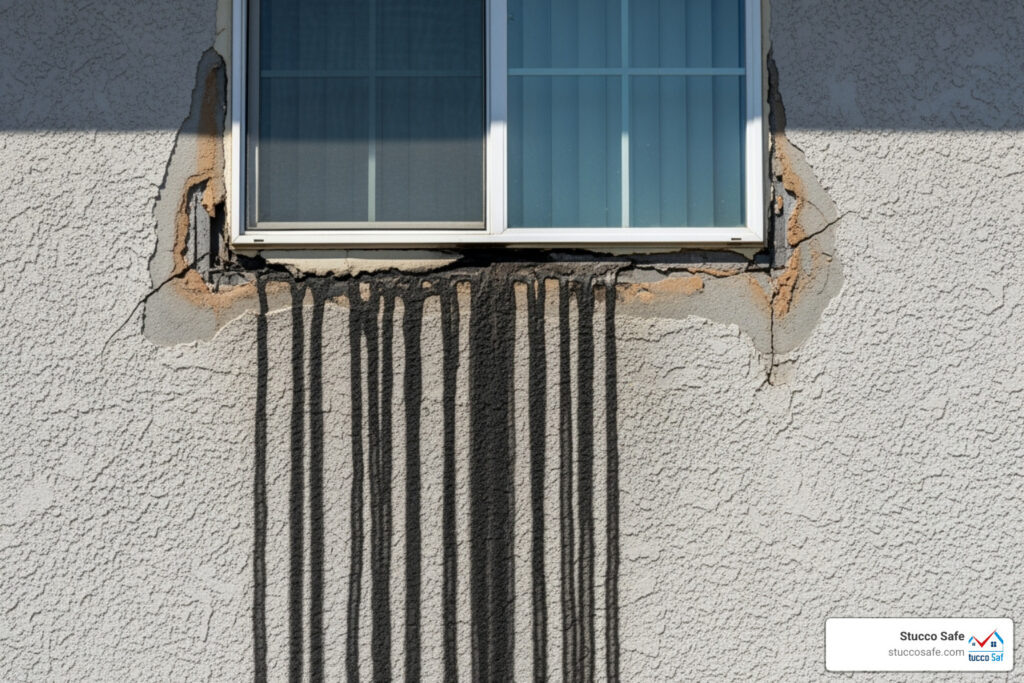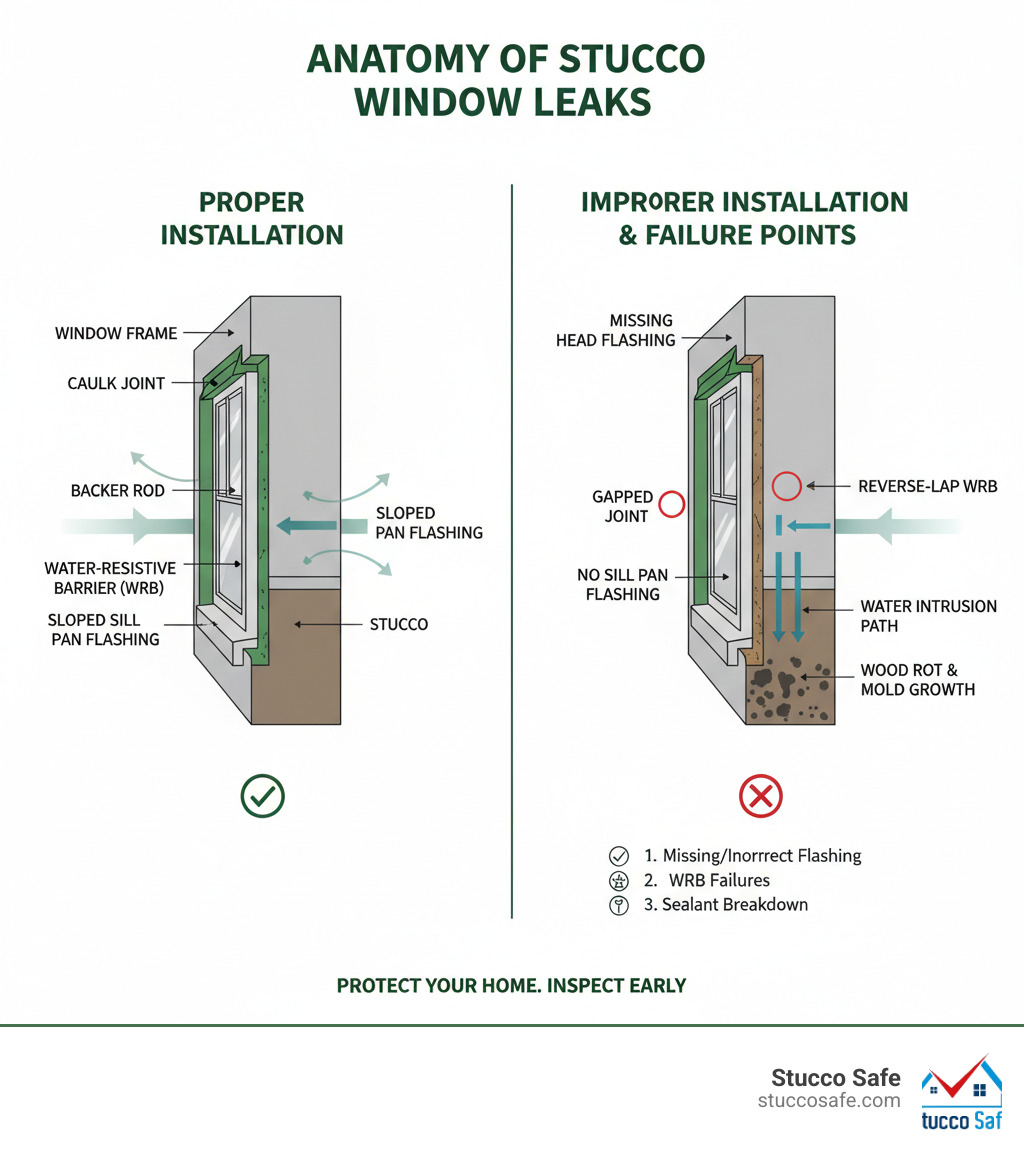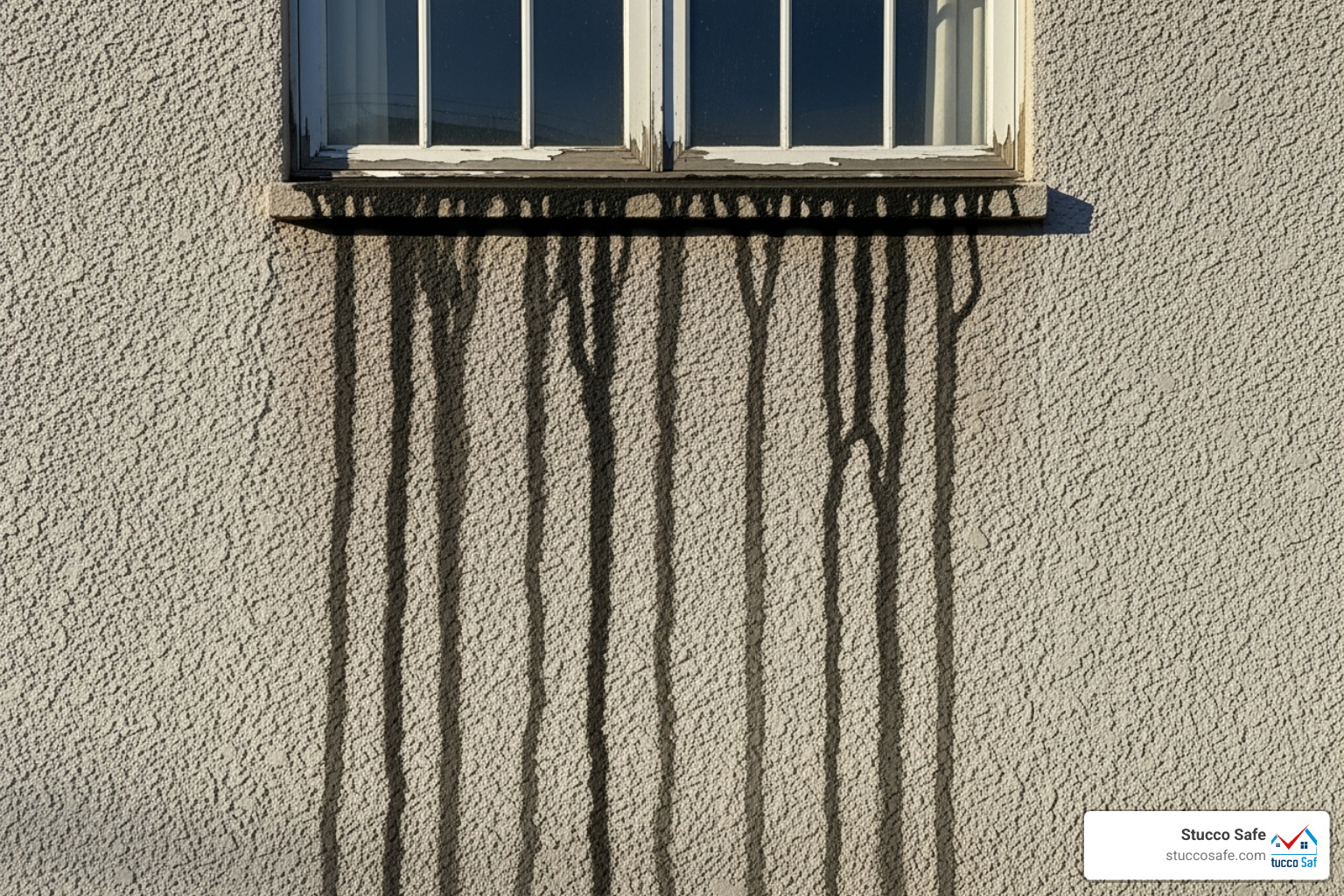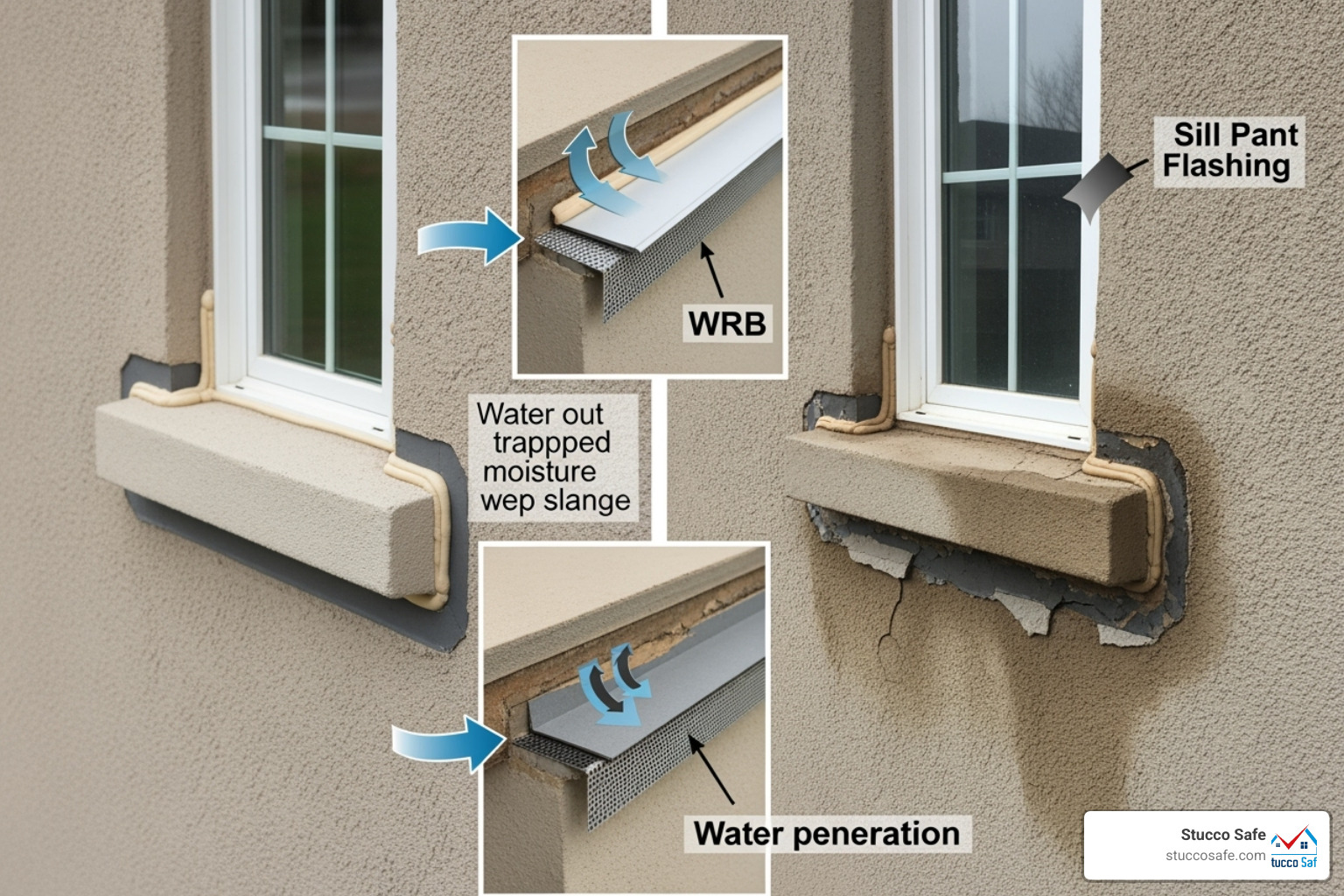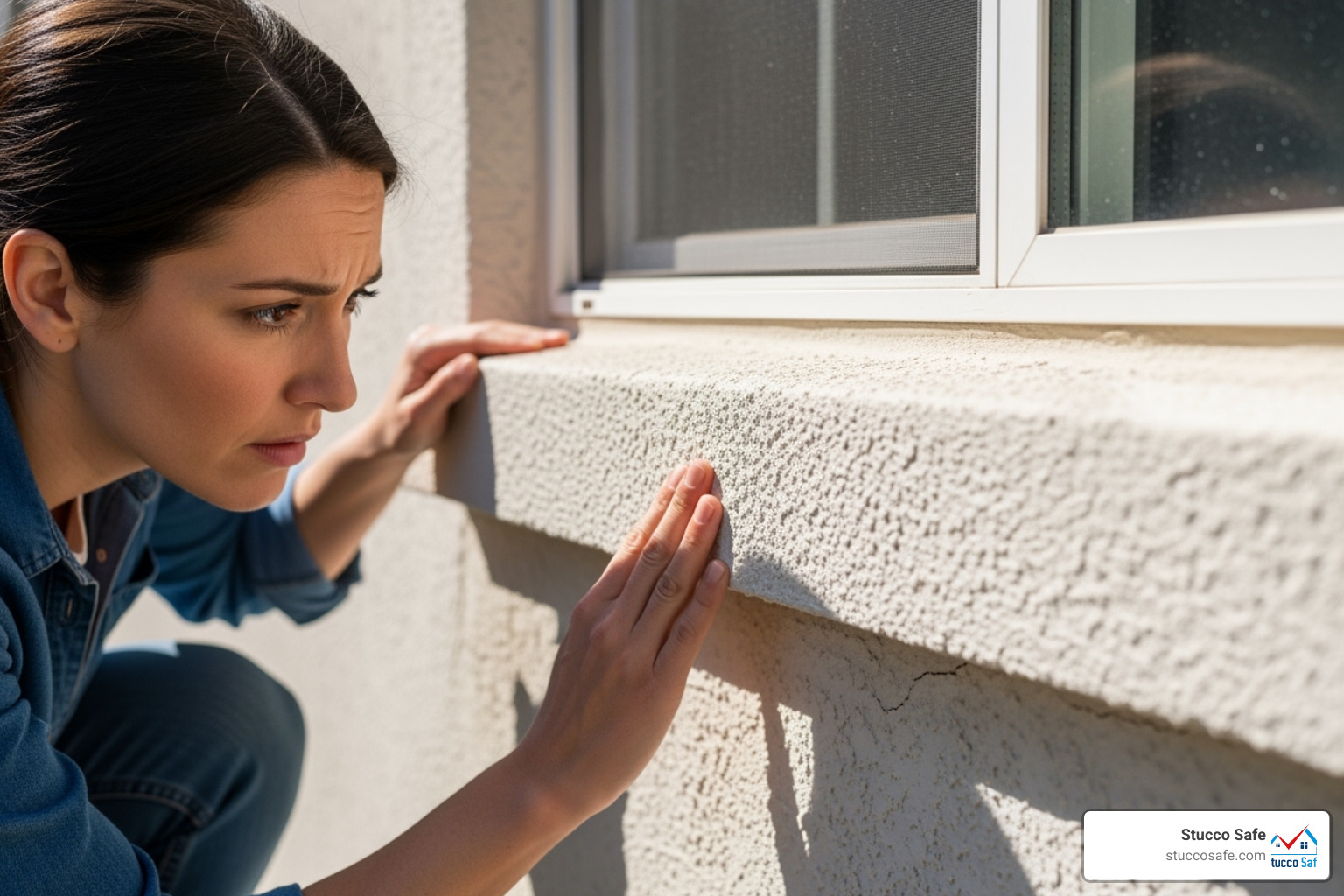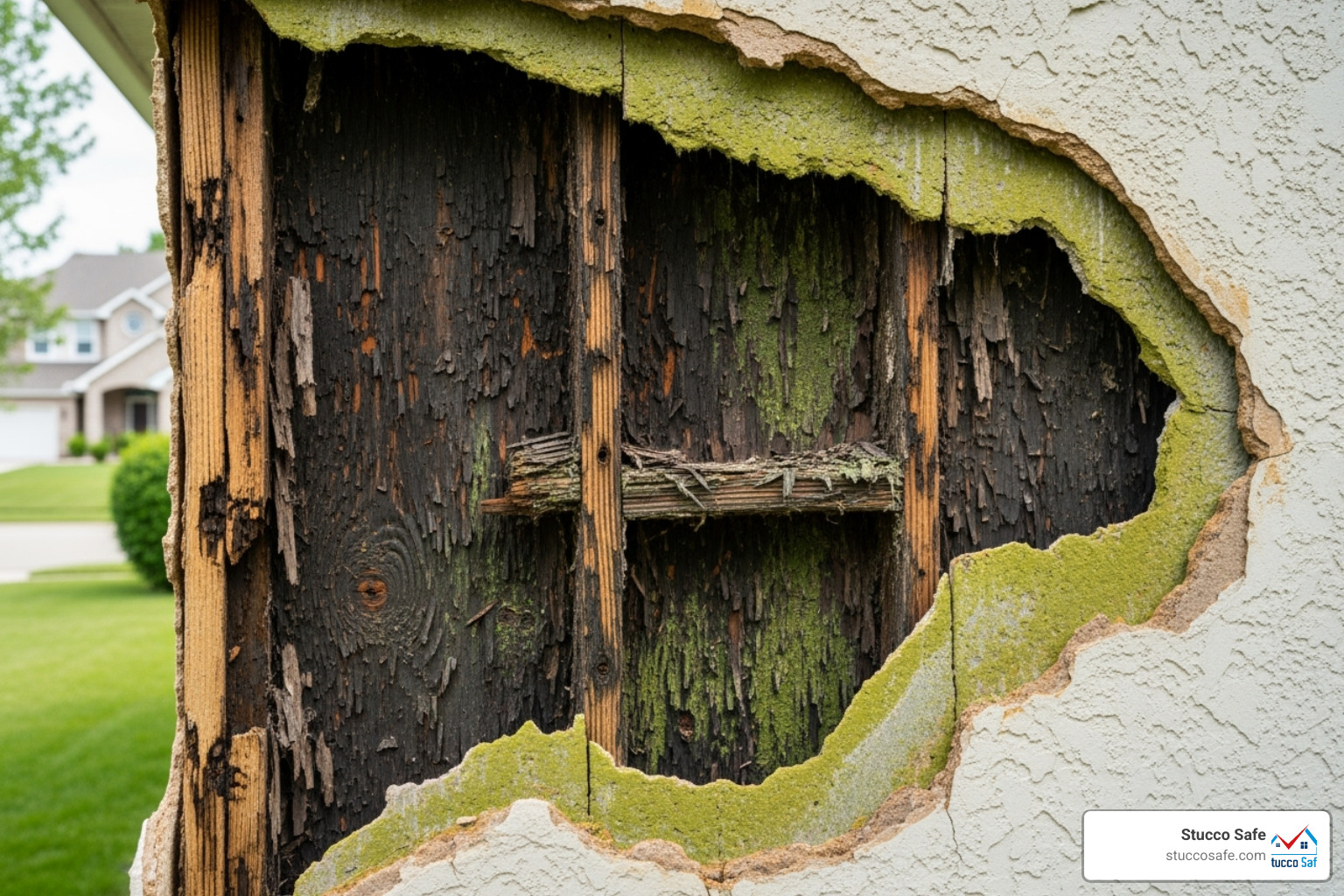Stucco Window Leaks: Prevent 3 Costly Problems
Why Stucco Window Leaks Demand Immediate Attention
Stucco window leaks are a common and potentially devastating problem for homeowners. Water intrusion around windows can cause thousands of dollars in hidden damage long before you notice the first warning signs.
Key aspects of stucco window leaks:
- Exterior signs: Dark stains below windows, cracked caulk, and bubbling stucco.
- Interior signs: Soft drywall, musty odors, peeling paint, and water stains.
- Root causes: The primary culprits are missing or improper flashing, failed water-resistive barriers, and sealant breakdown.
- Consequences: These failures can lead to wood rot, mold growth, structural damage, and a decrease in home value.
Stucco itself is not waterproof; it relies on flashing and moisture barriers to keep water out. When these systems fail, water penetrates the stucco and causes extensive hidden damage.
For example, one homeowner reported that an initial water damage estimate of $1,500 turned into over $15,000 in repairs once structural damage was uncovered. This shows how leaks can be far more extensive than they appear.
I’m Gabe Kesslick, a certified stucco inspector with over 20 years of experience. I’ve seen countless cases of stucco window leaks and know that early detection is critical to preventing costly structural damage and protecting your home’s value.
Spotting the Telltale Signs of a Leak
When it comes to stucco window leaks, your house provides clues if you know where to look. Catching these signals early is key to preventing a small problem from becoming a major headache. By examining both the exterior and interior of your home, you can spot the signs of water intrusion.
Exterior Warning Signs
Your stucco exterior often shows the first signs of trouble. Water leaves behind telltale marks as it makes its way into your walls.
The most obvious sign is dark, vertical staining running down from window corners. These brownish or black streaks show where water is escaping. If these stains remain long after rain, it’s a red flag.
Other key signs include:
- Stucco cracks: While not every crack indicates a leak, larger or persistent cracks around windows can be entry points for water.
- Bubbling or blistering stucco: This occurs when trapped water causes the stucco to separate from the wall underneath.
- Failed caulk and sealants: Gapping, cracking, or deteriorating caulk around windows signals a failure in a critical line of defense.
- Missing stucco: Chunks or chips of stucco missing near window edges often result from water damage and freeze-thaw cycles.
As professionals on the InterNACHI®️ Forum note, these exterior signs are your first alert. Learn more about these marks in our guide on Stucco Water Stains.
Interior Red Flags
Interior signs of stucco window leaks are especially concerning, as they mean water has already breached your home’s defenses.
Soft or spongy drywall beneath or around windows is a serious warning. If the wall feels damp or gives under pressure, moisture is accumulating inside.
A distinctive musty smell near windows, especially after rain, is often the first sign of hidden mold growth within wall cavities.
Other interior red flags include:
- Visible mold growth: This confirms an active moisture source is present. Our guide on How to Detect Mold in Your Home offers more insight.
- Water on windowsills: Pooling or persistent dampness is a direct sign that water is entering.
- Peeling or blistering paint: Moisture pushing paint from the surface indicates a slow, steady leak.
Ignoring these warnings often leads to more extensive and expensive repairs. Catching them early gives you the best chance to address the problem before it becomes a major structural issue.
The Root Causes of Stucco Window Leaks
The truth about stucco window leaks is that they are rarely the stucco’s fault. Stucco is porous by design; water will get through it. The real issue lies with the home’s water management system—the invisible shield behind the stucco. When this system fails, water begins its destructive journey into your walls. This is a core reason Why Does Stucco Have Problems?.
The Critical Role of Flashing
Flashing is a thin, waterproof material (usually metal or a flexible membrane) that acts as a gutter system around windows. When it fails, the results can be catastrophic.
Head flashing sits above the window to direct water away. A common mistake is to caulk the top of this flashing, which traps water inside the wall instead of letting it escape. Building codes like the IRC and IBC require proper flashing, yet we often find it missing, installed incorrectly, or poorly integrated.
Proper integration with the moisture barrier is essential. Flashing must connect seamlessly with the home’s water-resistive barrier (WRB) to create a continuous waterproof system. Shortcuts here create weak points for water penetration. Fixing a leaking window often requires removing the stucco to properly integrate new flashing.
Failures in the Water-Resistive Barrier (WRB)
Behind your stucco is the WRB, your home’s true raincoat. This membrane is what actually keeps water out of your walls. You can learn more about this critical component in our guide to Moisture Barrier Stucco.
Since stucco is porous, the WRB is designed to catch penetrating water and direct it safely outside. Common failures include:
- Improper overlaps: The WRB must be installed like shingles, with upper layers overlapping lower ones. Reversing this creates immediate weak spots.
- Tears and holes: Punctures in the WRB, often made during construction, allow water to soak the structure underneath.
- Missing weep screed: This trim at the bottom of walls creates a drainage gap. Without it, water gets trapped against the foundation.
Installation Errors and Sealant Breakdown
Many stucco window leaks trace back to contractors who don’t understand stucco’s requirements.
Improper caulking is a frequent mistake. Caulking over head flashing traps water, creating the very problem it was meant to solve. Even properly applied sealants break down over time due to UV exposure and temperature changes, creating entry points for water.
Inexperienced contractors may use “cut and caulk” methods for window replacement, sealing the edges without addressing the underlying WRB integration. This temporary fix, as noted on forums like DoItYourself.com, often makes the problem worse by hiding a persistent leak. These failures often stem from a lack of understanding about how stucco systems work.
How to Test for and Diagnose Leaks
When you suspect stucco window leaks, a systematic approach is better than grabbing a hose and spraying randomly. Water can travel in unexpected ways through wall cavities, so a stain may appear far from the actual entry point. Proper diagnosis requires patience and expertise.
Simple Visual and Moisture Checks
As a homeowner, you can gather important evidence before calling a professional.
Start with a thorough visual inspection of the interior and exterior signs discussed earlier. After rain, check for fresh stains, damp areas, or soft spots on the stucco. Pay close attention to the area above a suspected leak, as water follows gravity. Also, check for persistent dampness or a musty smell inside near windows.
A cautious homeowner can perform a preliminary water test by taping plastic over the window, then gently spraying water on the stucco above the window for a few minutes. If water appears inside, it likely points to a flashing or WRB issue.
Caution: This type of testing can be misleading, as water may enter in one spot and appear elsewhere. For this reason, we recommend professional assessment for anything beyond a basic visual check.
When to Call for Professional Leak Detection
Visual inspections only tell part of the story. Stucco window leaks often involve complex water pathways that require specialized tools and expertise for an accurate diagnosis.
You need an expert assessment if:
- Your visual checks are inconclusive.
- You find persistent moisture despite attempted repairs.
- You suspect the damage is more extensive than what is visible.
Our certified inspectors use specialized equipment for Stucco Leak Detection. Moisture meters detect water levels behind walls without damage, while thermal imaging cameras reveal hidden damp areas.
For a definitive diagnosis, we perform controlled invasive testing. This involves drilling small, easily patched holes to take precise moisture readings and visually inspect the structure. This forensic method, detailed in our guide on How is a Stucco Moisture Test Done?, helps us pinpoint the source of the leak, determine the extent of the damage, and create a clear plan for proper repairs.
The Hidden Dangers: Consequences of Ignoring Leaks
It’s tempting to ignore the first signs of stucco window leaks, but water damage doesn’t fix itself. What begins as a small stain can quickly escalate, affecting your wallet and your family’s health. The difference between minor and major damage is often just a matter of time.
Structural Damage and Rot
Once water gets behind your stucco, it begins to attack your home’s structure.
Wood sheathing decay is often the first casualty, as the plywood or OSB that provides wall strength turns soft and spongy. This is followed by more serious framing rot, where wooden studs and structural members decay, compromising your home’s integrity. This can lead to sagging walls and doors that no longer close properly.
Much of this damage happens out of sight. A small interior stain could hide extensive rot within the wall, which is why understanding Moisture Behind Stucco is so critical.
Rotting wood also attracts pests like termites and carpenter ants, which can accelerate the destruction. A water problem can quickly become a pest problem, too.
Health Risks and Interior Damage
The long-term effects of leaks on your family’s health can be just as serious as the structural damage.
Mold growth is almost inevitable when moisture is trapped in wall cavities. Mold can spread extensively before it’s visible, creating poor indoor air quality. The health risks from mold exposure are real, triggering allergies, asthma, and other respiratory issues. A musty smell is a clear warning of this hidden hazard.
Meanwhile, visible interior damage will continue to worsen. Drywall becomes soft, paint peels, and flooring can be ruined by constant moisture. These cosmetic issues are often just symptoms of a much larger problem. Our Mold Inspection in Stucco Homes service helps homeowners understand the full extent of the issue and take action to protect their health.
Ignoring stucco window leaks is a threat to your home’s structure and your family’s well-being. The longer you wait, the more complex and costly the solution becomes.
When to Call in the Professionals
While homeowner vigilance is important, diagnosing the full extent of stucco window leaks requires professional expertise. A simple-looking leak can have deep, hidden causes that threaten your home’s structure and your family’s health. If you need a trusted Stucco Inspector Near Me, we serve Philadelphia, West Chester, and communities throughout Southeastern PA, New Jersey, and Delaware.
Signs You Need an Expert for Stucco Window Leaks
It’s time to call a professional when you see these signs:
- Widespread or multiple issues: Extensive staining, soft spots, or leaks affecting multiple windows suggest a systemic problem.
- Soft or spongy stucco: If stucco gives way under pressure, it indicates the underlying materials are compromised, likely due to rot.
- Failed DIY repairs: If your attempts to patch a leak have failed, the problem is deeper than a surface-level fix can address.
- Buying or selling a home: A professional stucco inspection is essential to understand the home’s condition and avoid future surprises.
What a Certified Stucco Inspector Looks For
A general home inspector may not have the specific knowledge needed for stucco systems. That’s Why Hire a Separate Stucco Inspector?. Our certified specialists understand how stucco systems fail and can identify issues others miss.
We use specialized equipment, including non-invasive moisture meters and thermal imaging cameras, to detect hidden moisture. When necessary, we perform forensic testing by drilling small probe holes for precise moisture readings and visual inspection of the underlying structure. We also assess building code compliance, as many leaks stem from installations that failed to meet IRC and IBC standards.
Our inspections typically range from $495 to $1595. Considering that unaddressed moisture can lead to tens of thousands in repairs, this is a small investment for peace of mind.
Frequently Asked Questions about Stucco Window Leaks
Homeowners often have questions about stucco window leaks. Here are answers to the most common ones.
Can I just caulk around the window to stop the leak?
While it’s a common instinct, caulking a leak is usually a temporary band-aid that can make things worse. The real problem is typically a failure in the hidden water-resistive barrier or flashing system. Caulking over the head flashing at the top of a window is particularly dangerous, as it traps water inside the wall, leading to rot. Professional sealants have a role, but only after the underlying moisture barrier issues are properly diagnosed and repaired.
How much does it cost to repair a stucco window leak?
The cost varies widely depending on the extent of the damage.
- Minor repairs: For small, localized issues caught early, costs might range from $400 to $1,800.
- Major remediation: Costs can escalate significantly if there is extensive hidden damage. One homeowner’s initial $1,500 estimate ballooned to over $15,000 after severe structural rot was finded. Major repairs involve removing stucco, replacing rotted wood, installing new flashing and moisture barriers, and then rebuilding the wall system. This can cost tens of thousands of dollars.
A professional inspection is a smart investment to understand the true scope of work. Learn more in our guide to Stucco Inspection Costs: What to Expect.
Does homeowners insurance cover stucco water damage?
Coverage depends on your policy and the cause of the damage. Insurance companies distinguish between sudden and accidental damage (like from a storm), which is often covered, and gradual damage from poor installation or lack of maintenance, which is typically excluded.
Most policies exclude damage from long-term neglect. An insurer may argue that a slow leak was a preventable maintenance issue. Documentation is critical. A professional inspection report identifying the cause and extent of the damage can be crucial for a successful claim. For more details, read our article on Does Homeowners Insurance Cover Stucco Problems?.
Conclusion: Protecting Your Stucco Home
Stucco window leaks can cause serious damage, but you can protect your home with proactive maintenance and early detection. The key is understanding that stucco is a system. The porous outer layer relies on a hidden defense of flashing and moisture barriers to keep your home dry.
Success comes down to three principles:
- Early Detection: Regularly check for warning signs like stains, soft drywall, or musty smells.
- Proactive Maintenance: Keep an eye on caulk joints and address cracks promptly.
- Proper Repairs: Understand that a real fix often requires professional expertise to address underlying flashing or barrier issues, not just a tube of caulk.
Waiting to address a small leak can turn a manageable repair into a major renovation. The difference between a sub-$1000 inspection and a $15,000+ structural repair is often just a matter of timing.
At Stucco Safe, we are your partners in protecting your investment. Our certified inspectors use forensic testing to give you a complete picture of your home’s condition. We serve communities throughout Southeastern Pennsylvania, New Jersey, and Delaware.
Your home is your largest investment. Don’t let uncertainty about a suspicious stain keep you up at night.
If you suspect moisture problems with your stucco, don’t wait for the damage to spread. Contact us today to schedule an inspection and gain the peace of mind that comes from knowing exactly where your home stands. When it comes to stucco window leaks, knowledge is protection.

